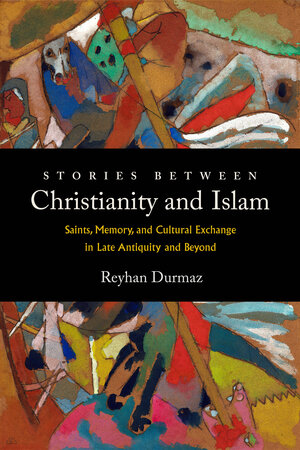By Reyhan Durmaz, author of Stories between Christianity and Islam: Saints, Memory, and Cultural Exchange in Late Antiquity and Beyond
We all tell stories to create meaning. A far-gone event in a distant time and place often works as a lens through which we remember the past, interpret the present, and envision the future. I remember the early days of the Covid-19 pandemic when many of us turned to the scriptures to understand our moment. The stories of catastrophes, punishment, repentance, and forgiveness in the Hebrew Bible, the New Testament, and the Qur’an were all suddenly a big part of our newly isolated lives. We compared and prophesized, remembering the stories of prophets and sinners of the past.
The scriptures were not the only source of stories to be called upon for help. Historical accounts of the black death and other past pestilence, as well as novelistic descriptions of imagined pandemics, added to our rich storyscape in the past three years. Albert Camus’ The Plague (1947), Dean Koontz’s The Eyes of Darkness (1981), and other works of fiction entered the bestseller lists in 2020. Our pandemic stories rest upon such a foundation of prior stories, with our understanding of the biblical, historical, and fictional blending into each other.
These are shared stories, yet we are often divided on how to interpret the stories of the past. Some see them as a source of apocalyptic prophecies of doom, others as a basis for hope and resilience. While the democratic nature and transformative power of storytelling are commonly acknowledged, clerics, scholars, politicians, journalists, and artists argue about the ways that shared stories of the past could or should be interpreted. “Don’t fear death, like martyrs did not,” preached some. “If the Apostles did not witness the Crucifixion and could still be holy, why can’t we protect our lives and still hope for salvation?” asked others. Our shared stories became our battlegrounds, dividing people into us and them.
All of this was on my mind while I wrote Stories between Christianity and Islam. As I witnessed the ways in which biblical and other stories were used to make meaning of the pandemic in various religious communities, I explored what it meant for Christian and Muslim communities in the Middle Ages to share stories of the divine past. I wondered, how and why were certain stories of saintly figures transmitted between Christianity and Islam?
The book starts with Late Antiquity, the period that connects the development of Christianity into an imperial religion to the emergence of Islam. In this time interval, parallel to the canonization processes of the Hebrew Bible and the New Testament, exegetical storytelling created what some scholars refer to as a scriptural universe. Stories of the divine past were expanded and interpreted in literary, material, and embodied ways and communicated to broad audiences who had no direct access to written texts. I reconstruct the narrators, audiences, and contexts of devotional storytelling (which I call hagiodiegesis, as an alternative to hagiography), since transmissions of stories between communities often took place through this oral-aural practice.
I then focus on Muhammad as a narrator and interpreter of stories and show how the Qur’an complemented the scriptural universe of Late Antiquity. It is thanks to Muhammad and numerous others, who had the skill to narrate, interpret, and debate about narratives, that stories of heroes and villains of the divine past were transmitted into and reshaped in the early Islamic community. The book then continues into the Middle Ages and analyzes the continued engagement between Christians and Muslims in the shared space of hagiographic storytelling.
In scholarly discussions about such transmissions of stories there are two prominent proposals. Some argue that most stories shared between Christianity and Islam are in fact created by drawing from a shared pool of tropes. And cultural encounter and exchange, the argument goes, is difficult to identify when there is this common pool of shared symbols and expressions in between. Others use source-critical methods to identify the specific texts that underlie the stories in Islamic literature. Tracing stories from point A to point B, while immensely useful in reconstructing the vectors of transmission, assesses texts in relation to their subtexts. My book sheds light on the broad grey zone between these two ends by bringing to the fore the agencies and creativity that shaped the transmissions of personas —rather than literary tropes or whole stories— between Christianity and Islam.
The well-known holy man Antony of Egypt, for example, appears in a 9th-century Islamic exposition on the fear of God. Antony is recognizable in this text as a 4th-century ascetic in dwelling in the Egyptian desert, but he is attributed a whole new story. The persona seems to have crossed the confessional boundary, but the story does not. In light of this and other examples, Stories between Christianity and Islam develops a frame for the various roles Christian saints’ stories played in Islamic literature, and the degrees to which they were “Islamized.” Each case study, in addition to showing the transformation of the saint, also shows the intricate ways in which Muslims continued to engage with Christian hagiography. This continued engagement indicates that transmissions of stories between Christianity and Islam were not products of one-time encounters but were conversations on a continuum of exchange and negotiation, remembrance and erasure.
Stories between Christianity and Islam covers a broad geographical and chronological span. With the stories analyzed in these pages, the authority of storytellers, canonical books, and institutions are destabilized vis-à-vis the participation of audiences, extra-canonical writings, and households in remembering the divine past. My hope is that the book brings exciting questions into this dynamic field of inquiry and adds nuance to the intertwined histories of Christianity and Islam.

